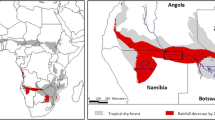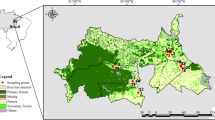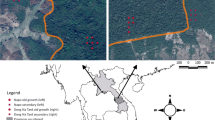Abstract
Secondary successional vegetation represents one-third of the 7% of the original area covered with tropical dry forest that remains in central Veracruz, Mexico. In this region, fallow periods are short, in general, no longer than 7–10 years, and old secondary successional sites are not available. Therefore we evaluated the potential of very early successional stages of tropical dry forest with different land use histories for recovering the structure and composition of regional forest. We compared five early successional sites (7–72 months) with five nearby forest remnants. Successional sites had reached 38 and 30%, respectively, of the average basal area and density recorded for the forest understories, but only 5 and 10%, respectively, of the basal area and density of forest overstories. A total of 132 tree species were recorded, 45 at successional and 107 at forest sites. Individuals of tree species with animal-dispersed seeds (57%) were significantly better represented than wind-dispersed (22%) and self-dispersing (21%) species in both successional and forest sites. Successional sites had already recruited 10% of the intermediate and shade-tolerant species that grow in forest remnants. However, only 20 species occurred in both early successional and forest sites, several showing resprouting ability. We conclude that the entry of forest species to the successional process at very early stages and the recruitment of individuals from resprouting may facilitate the recovery of the dry forest in Veracruz.






Similar content being viewed by others
References
Angiosperm Phylogeny Group (2003) An update of the Angiosperm Phylogeny Group classification for the orders and families of flowering plants: APG II. Bot J Linn Soc 141:399–436
Castillo-Campos G, Medina-Abreo ME (2002) Árboles y Arbustos de la Reserva Natural de La Mancha, Veracruz. Instituto de Ecología A.C. Xalapa, México
Challenger A, Dirzo R (2009) Factores de cambio y estado de la biodiversidad. In: Capital natural de México vol II: estado de conservación y tendencias de cambio. CONABIO, México, pp 37–73
Chazdon RL, Letcher SG, van Breugel M, Martínez-Ramos M, Bongers F, Finegan B (2007) Rates of change in tree communities of secondary Neotropical forests following major disturbances. Phil Trans R Soc B 362:273–289
Colwell RK (2006) EstimateS: statistical estimation of species richness and shared species from samples. Version 8. <Persistent URL purl.oclc.org/estimates>
Corlett RT (2009) Seed dispersal distances and plant migration potential in tropical East Asia. Biotropica 41:592–598
Curtis JT, McIntosh RP (1951) An upland forest continuum in the prairie-forest border region of Wisconsin. Ecology 32:476–496
de Noir FA, Bravo S, Abdala R (2002) Mecanismos de dispersión de algunas especies de leñosas nativas del Chaco Occidental y Serrano. Quebracho 9:140–150
Egler FE (1954) Vegetation science concepts. 1 Initial floristic composition, a factor in old-field vegetation development. Vegetatio 4:412–417
Ewel JJ (1977) Differences between wet and dry successional tropical ecosystems. Geo-Eco-Trop 1:103–117
Ewel JJ (1980) Tropical succession: manifold routes to maturity. Biotropica 12:2–7
Gillespie TW (1999) Life history characteristics and rarity of woody plants in tropical dry forest fragments of Central America. J Trop Ecol 15:637–649
González-Iturbe JA, Olmsted I, Tun-Dzul F (2002) Tropical dry forest recovery after long term Henequén (sisal, Agave fourcroydes Lem.) plantation in northern Yucatán, Mexico. For Ecol Manage 167:67–82
Griscom HP, Griscom BW, Ashton MS (2009) Forest regeneration from pasture in the dry tropics of Panama: effects of cattle, exotic grass, and forested riparia. Restor Ecol 17:117–126
Griz LMS, Machado ICS (2001) Fruiting phenology and seed dispersal syndrome in caatinga, a tropical dry forest in the northeast of Brazil. J Trop Ecol 17:303–321
Guariguata MR, Ostertag R (2001) Neotropical secondary forest succession: changes in structural and functional characteristics. For Ecol Manage 146:185–206
Justiniano MJ, Fredericksen TS (2000) Phenology of tree species in Bolivian dry forests. Biotropica 32:276–281
Kalacska M, Sánchez-Azofeifa GA, Calvo-Alvarado JC, Quesada M, Rivard B, Janzen DH (2004) Species composition, similarity and diversity in three successional stages of a seasonally dry tropical forest. For Ecol Manage 200:227–247
Kammesheidt L (1998) The role of tree sprouts in the restoration of stand structure and species diversity in tropical moist forest after slash-and-burn agriculture in Eastern Paraguay. Plant Ecol 139:155–165
Kennard DK (2002) Secondary forest succession in a tropical dry forest: patterns of development across a 50-year chronosequence in lowland Bolivia. J Trop Ecol 18:53–66
Killeen TJ, Jardim A, Mamani F, Rojas N (1998) Diversity, composition and structure of a tropical semideciduous forest in the Chiquitania region of Santa Cruz, Bolivia. J Trop Ecol 14:803–827
Laborde J, Guevara S, Sánchez-Ríos G (2008) Tree and shrub seed dispersal in pastures: the importance of rainforest trees outside forest fragments. Ecoscience 15:6–16
Lebrija-Trejos E, Bongers F, Pérez-García EA, Meave JA (2008) Successional change and resilience of a very dry tropical deciduous forest following shifting agriculture. Biotropica 40:422–431
Lebrija-Trejos E, Pérez-García EA, Meave JA, Bongers F, Poorter L (2010) Functional traits and environmental filtering drive community assembly in a species-rich tropical system. Ecology 91:386–398
Markesteijn L, Poorter L, Bongers F (2007) Light-dependent leaf trait variation in 43 tropical dry forest tree species. Am J Bot 94:515–525
McLaren KP, McDonald MA (2003) Coppice regrowth in a disturbed tropical dry limestone forest in Jamaica. For Ecol Manage 180:99–111
Miller PM, Kauffman JB (1998) Effects of slash and burn agriculture on species abundance and composition of a tropical deciduous forest. For Ecol Manage 103:191–201
Molina Colón S, Lugo AE (2006) Recovery of a subtropical dry forest after abandonment of different land uses. Biotropica 38:354–364
Mostacedo B, Putz FE, Fredericksen TS, Villca A, Palacios T (2009) Contributions of root and stump sprouts to natural regeneration of a logged tropical dry forest in Bolivia. For Ecol Manage 258:978–985
Murphy PG, Lugo AE (1986) Ecology of tropical dry forest. Annu Rev Ecol Syst 17:67–88
Newton AC (2008) Restoration of dryland forests in Latin America: the ReForLan project. Ecol Rest 26:10–13
Ortiz J, López-Barrera F, Callejas J (2010) A historical reconstruction of the land use patterns from 1920 to 1960 in communal lands of Paso de Ovejas, Veracruz, Mexico. In: Newton A (ed) Principles and practice of forest landscape restoration. Case studies from the drylands of Latin America. IUCN. Accepted
Poorter L (2009) Leaf traits show different relationships with shade tolerance in moist versus dry tropical forests. New Phytol 181:890–900
Quesada M, Sanchez-Azofeifa GA, Alvarez-Añorve M et al (2009) Succession and management of tropical dry forests in the Americas: review and new perspectives. For Ecol Manage 258:1014–1024
Read L, Lawrence D (2003) Recovery of biomass following shifting cultivation in dry tropical forests of the Yucatán. Ecol Appl 13:85–97
Romero-Duque LP, Jaramillo VJ, Pérez-Jiménez A (2007) Structure and diversity of secondary tropical dry forests in Mexico, differing in their prior land-use history. For Ecol Manage 253:38–47
Ruiz J, Fandiño MC, Chazdon RL (2005) Vegetation structure, composition, and species richness across a 56-year chronosequence of dry tropical forest on Providencia Island, Colombia. Biotropica 37:520–530
Ruschel AR, Nodari RO, Moerschbacher BM (2007) Woody plant species richness in the Turvo State park, a large remnant of deciduous Atlantic forest, Brazil. Biodivers Conserv 16:1699–1714
Sabogal C (1992) Regeneration of tropical dry forests in Central America, with examples from Nicaragua. J Veg Sci 3:407–416
Sampaio AB, Holl KD, Scariot A (2007a) Regeneration of seasonal deciduous forest tree species in long-used pastures in Central Brazil. Biotropica 39:655–659
Sampaio AB, Holl KD, Scariot A (2007b) Does restoration enhance regeneration of seasonal deciduous forests in pastures in central Brazil? Restor Ecol 15:462–471
Trejo I, Hernández J, García-Guzmán G (2007) El impacto del cambio de uso del suelo en los bosques tropicales caducifolios en México. Paper presented at the XVII Mexican Congress of Botany, 14–18 October. Zacatecas, Zacatecas, Mexico
van der Pijl L (1972) Principles of dispersal in higher plants. Springer, Berlin, Germany
Viera DLM, Scariot A (2006) Principles of natural regeneration of tropical dry forests for restoration. Restor Ecol 14:11–20
Williams-Linera G, Lorea F (2009) Tree species diversity driven by environmental and anthropogenic factors in tropical dry forest fragments of central Veracruz, Mexico. Biodivers Conserv 18:3269–3293
Zar JH (1999) Biostatistical analysis, 4th edn. Prentice Hall, Englewood Cliffs
Acknowledgments
We are grateful to María de Jesús Peralta for her valuable assistance in the field and herbarium, Francisco Lorea for reviewing the taxa and functional groups, Fabiola López Barrera and Arturo Piña for help in the preparation of Figs. 1 and 3, and two anonymous reviewers for suggestions to improve the manuscript. This research was funded by the European Community under INCO Project ReForLan (CT2006-032132).
Author information
Authors and Affiliations
Corresponding author
Appendix
Appendix
See Table 3.
Rights and permissions
About this article
Cite this article
Williams-Linera, G., Alvarez-Aquino, C., Hernández-Ascención, E. et al. Early successional sites and the recovery of vegetation structure and tree species of the tropical dry forest in Veracruz, Mexico. New Forests 42, 131–148 (2011). https://doi.org/10.1007/s11056-010-9242-8
Received:
Accepted:
Published:
Issue Date:
DOI: https://doi.org/10.1007/s11056-010-9242-8




